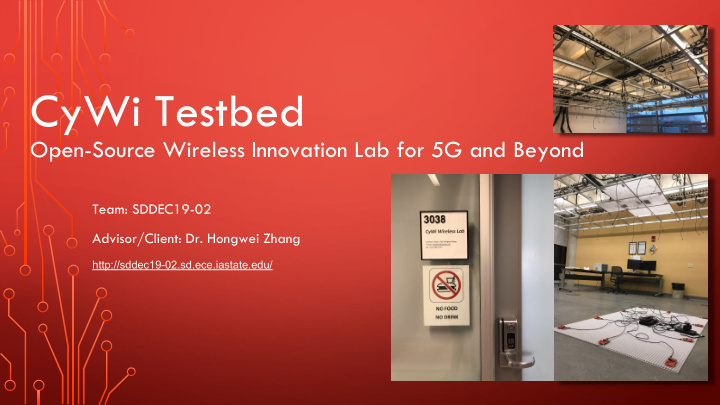



CyWi Testbed Open-Source Wireless Innovation Lab for 5G and Beyond Team: SDDEC19-02 Advisor/Client: Dr. Hongwei Zhang http://sddec19-02.sd.ece.iastate.edu/
Project Plan
Problem Statement ● Smart agriculture (e.g. modern machinery control) demands robust 5G solutions ● Industry 4.0 requires Cyber-Physical Systems (CPS) and Internet of Things (IoT) ● Wireless labs and testbeds speed up the pace of innovation ○ Simulations are not sufficient - radio frequency (RF) research needs physical labs ● CyWi will enable users to define, execute, and analyze wireless experiments
Experiment Lifecycle ● Specification ○ Users provide requests in spec scripts ● Resource Allocation ○ Server unpacks the spec script ○ Server reserves the requested resources (nodes, frequencies, etc) ● Node Self-configuration ○ Nodes receive data for configurations from the database/server ● Experiment Control ○ Performance monitoring, logs, traffic output are collected and exported to the user
Functional Requirements ● System must register users and assign individual accounts ● Resource scheduler must efficiently allocate node resources ● Experiments must be run remotely via web server ● Users will have the ability to export experiment results
Non-functional Requirements ● System status will be tracked and available to users ● Only registered users can access the system ● System must be crash resilient ● Database will be backed up on regular basis ● Software used will be open-source
Constraints and Considerations ● Limited ceiling tiles arranged in a grid of 11x10 tiles ● Limited budget for powerful SDRs and quantity of CPS motes ● Project scope is large and multi-year -- documentation is crucial for continued future development
Market Survey ● ORBIT - Rutgers University ○ WiFi, WiMAX, OpenFlow, and USRP2 ○ Over 100 research papers have been published with data obtained from the testbed ● Powder - University of Utah ○ 4G/5G, MIMO, OpenAirInterface (OAI), OpenStack ● NetEye - Wayne State University ○ Wireless sensor networks (WSN)
Potential Risks & Mitigation ● Security Considerations ○ Restricted access to the locked lab room ○ User approval system for testbed account creation ○ Server will store minimal user personal information ● Safety Concerns ○ Few during installation, electrical wiring (performed by ETG) ○ Large quantity of cables connecting all components could have been a hazard so the nodes were mounted on the ceiling
Current Cost Estimate
Future Cost Estimate
Project Milestones & Schedule
Project Milestones & Schedule
System Design
Functional Decomposition
High-Level System Architecture Diagram ● Users connect via web interface ● Services include SSH, FTP, MySQL, Access Control, Resource Scheduler, Node Configuration Manager ○ Emulab platform will provide many of these functions ● Node Controllers are accessible and provide management to SDR nodes, but are transparent to the CPS motes
Hardware Platforms ● CPS Motes : Texas Instruments CC26X2R Wireless Development Boards ○ Bluetooth 5 Low Energy ○ Zigbee (802.15.4) ○ Wi-Fi ● SDR Nodes : Ettus Research USRP B210 ○ Frequency Range: 70MHz – 6GHz ○ Throughput: 61.44MS/s ○ USB 3.0 Connectivity
Hardware Platforms ● Node Controllers : Intel NUC8i7HVK Mini-PCs ○ CPU: Intel i7-8559U (2.7GHz up to 4.5GHz) ○ Memory: 32GB DDR4 ○ Storage: 1xSATA, 1xM.2 ○ GPU: Intel Iris Plus 655 ● Server : Dell Precision 3000 ○ CPU: Intel Xeon Bronze ○ Memory: 16GB ○ Storage: 4 TB raid 1 ○ GPU: integrated
Software Platforms CPS Motes: Texas Instruments CC26X2R Wireless Development Boards ● WiFi, Bluetooth, and Zigbee ● SimpleLink Wireless Development Tools SDR Nodes: Ettus Research USRP B210 ● Linux Ubuntu 16.04 ● OpenAirInterface 5G Development Tools ● GNU Radio
Test Plan ❏ Most of the functional testing will be unit testing ❏ As we finish and test more small pieces, we will integrate and test as a larger system Main Functional Tests ● ● Experiment Results Exportation Account Registration ● ● Resource Reservation/Scheduling Remote Web Server Access ● User’s Spec Script Execution
Test Plan ❏ Most non-functional tests will involve how the system continues to run and back up data ❏ Also includes security and accessibility Non Functional Tests ● ● Responsive UI Availability ● ● Database Backup Security ● ● Accessibility System Status and Resiliency
Tests Performed (Results) ● CPS Motes ○ SimpleLink platform runs without errors ○ Transmissions at full power achieved 0.08% packet loss ● SDR Nodes ○ Currently, we had not yet had success communicating with the SDRs ○ Bugs by Ubuntu to be resolved ● Server ○ Pending hardware arrival
Conclusion
Current Project Status In Relation To Roadmap ● Defined testbed and roadmap plan ● Node Controllers installed ● CPS motes and SDR nodes are installed ● Node Controllers don’t have Linux installed yet ● Server is ordered and currently in transit (pending ETG) ● Node Controller Manager is pending server installation
Individual Team Member Contributions ● Shay (CPS) - Zigbee network setup and performance testing ● Tyler (CPS) - Bluetooth network setup and performance testing ● Chen-Ye (SDR) - OpenAirInterface research and hardware order/setup ● Jian (SDR) - Powder demonstration and Linux setup ● Ryan (Server) - Hardware analysis and ordering ● Pawel (Server) - ORBIT/Powder demonstrations and Emulab installation research
Plans for Fall 2019 ● Node Controller interaction with SDR nodes and CPS/IoT motes ● Emulab installation and integration with the rest of the system ● Basic profile configurations and images for testbed tutorials/walkthroughs ● Web interface creation and optimization ● Testing - includes RF signals, configurations, user interface, etc ● Iterative platform refinements ● Documentation, Documentation, Documentation!
Thank you for listening. Any questions?
Recommend
More recommend